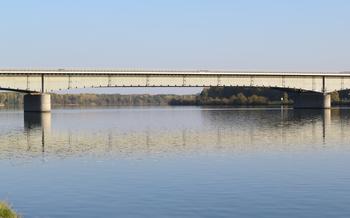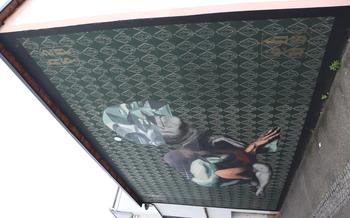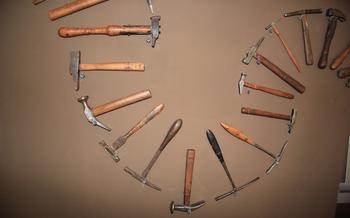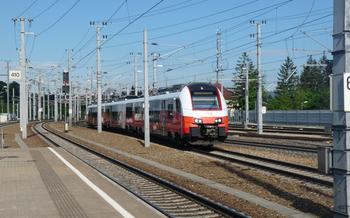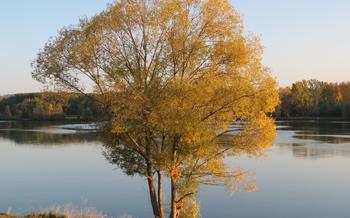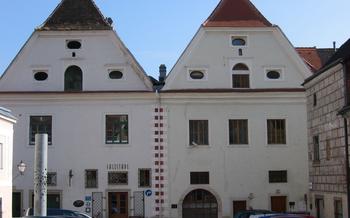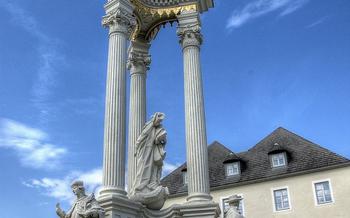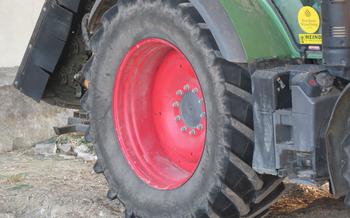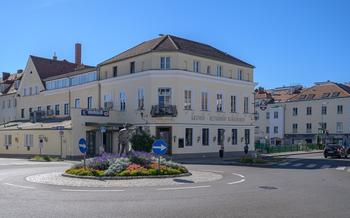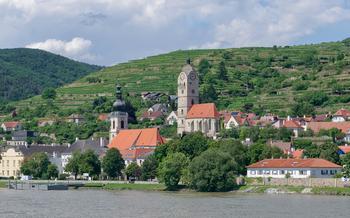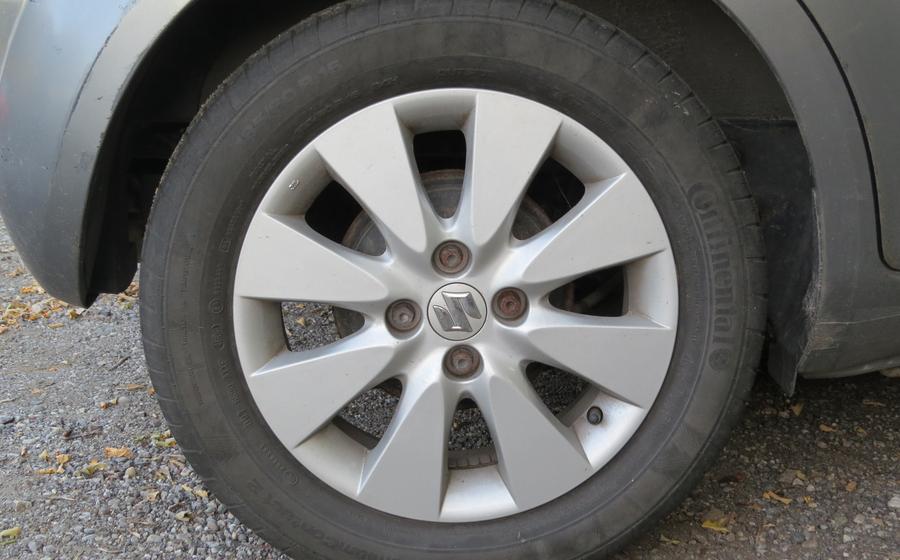
Venus of Willendorf's Site Museum
- A Journey Through Time
- The Willendorf Site Museum
- The Venus in Context
- A Masterpiece of Prehistoric Art
- Hands-on Experience:
- Beyond the Venus
- A Walk Through History
- Local Legends and Folklore
- The Venus in Popular Culture
- Research and Conservation
- Temporary Exhibitions
- Accessibility and Facilities:
- Souvenirs and Merchandise
- Insider Tip: Willendorf Festival
A Journey Through Time
For millennia, a small limestone figurine unearthed in 1908 from a gravel quarry in Willendorf has captivated the world. Known as the Venus of Willendorf, this enigmatic artifact is a testament to the rich cultural tapestry of prehistoric Europe. Its discovery marked a significant milestone in our understanding of human history and artistic expression.
The timeline of the Venus's journey is a fascinating tale of chance encounters and meticulous research. In 1908, during a routine excavation at the Willendorf site in Lower Austria, a team of archaeologists stumbled upon the remarkable statuette lying amidst a treasure trove of Stone Age tools and animal bones. The figurine, remarkably well-preserved, sparked instant intrigue among scholars and enthusiasts alike.
However, controversy soon swirled around its origins. Some experts questioned whether the Venus was truly prehistoric, suggesting it might be a more recent creation. Others debated its cultural and geographical context, as similar figurines had been discovered in far-flung regions. Through painstaking analysis and ongoing research, the Venus of Willendorf has been firmly placed within the Paleolithic era, and its cultural significance has been acknowledged as a testament to the artistic and symbolic expressions of our prehistoric ancestors.
The Willendorf Site Museum
The Willendorf Site Museum, situated in the heart of Krems an der Donau, offers an immersive journey into the world of the Venus of Willendorf. Designed by the renowned Viennese architect Adolf Krischanitz, the museum seamlessly blends contemporary architecture with the historical significance of the site.
The building's striking exterior, characterized by its sleek lines and minimalist aesthetic, harmonizes with the surrounding landscape, creating a sense of continuity between the past and present. Inside, visitors are greeted by a spacious and well-lit exhibition space, where the Venus figurine takes center stage. Interactive exhibits and multimedia presentations provide visitors with an in-depth understanding of the figurine's history, cultural context, and artistic significance.
The museum's layout encourages visitors to explore the various aspects of the Venus of Willendorf and its era. Artifacts from the Willendorf site, such as stone tools, weapons, and other objects, are displayed alongside the figurine, providing a glimpse into the daily lives of prehistoric inhabitants. Educational programs and workshops are regularly offered, allowing visitors, especially children and families, to engage with the past through hands-on activities and interactive exhibits.
The Venus in Context
The Venus of Willendorf is not just a standalone artifact; it is deeply embedded in the context of the Paleolithic era in Austria. To fully appreciate the significance of this figurine, it is essential to explore the lifestyle and culture of the prehistoric inhabitants who created it.
During the Paleolithic era, which spanned from around 6 million to 10,000 years ago, humans lived in small nomadic groups and relied on hunting and gathering for sustenance. The climate was harsh and unpredictable, and survival was a constant challenge. Despite these difficulties, prehistoric people displayed remarkable creativity and ingenuity. They crafted tools and weapons from stone, bone, and antler, and developed intricate social and cultural practices.
The Venus of Willendorf is one of the most iconic examples of Paleolithic art. It is believed to have been created by the Gravettian culture, which flourished in Europe from around 30,000 to 20,000 years ago. Gravettian people were skilled hunters and artists, and their culture produced a wide range of artifacts, including Venus figurines, animal carvings, and decorated tools.
The Willendorf site itself has yielded a wealth of archaeological discoveries, providing valuable insights into the lives of prehistoric people in the region. Excavations have uncovered stone tools, weapons, and other artifacts, as well as the remains of hearths and dwellings. These findings suggest that the site was a hunting camp or a seasonal settlement, where people gathered to hunt, gather food, and socialize.
A Masterpiece of Prehistoric Art
The Venus of Willendorf is widely regarded as a masterpiece of prehistoric art, embodying the essence of human creativity and craftsmanship.
Hands-on Experience:
The Willendorf Site Museum offers visitors a unique opportunity to delve deeper into the world of prehistoric art and craftsmanship through hands-on experiences. Visitors can unleash their creativity and create their own replicas of the Venus figurine, using materials and techniques similar to those employed by our ancestors. Skilled artisans conduct workshops and demonstrations, providing insights into the processes and tools used to craft these remarkable figurines. Interactive exhibits allow visitors to engage with the past as they explore the role of art and creativity in human history. Educational programs for children and families provide an opportunity for younger visitors to learn about the Venus and her significance while engaging in hands-on activities that foster curiosity and imagination.
Beyond the Venus
The Willendorf site has yielded a treasure trove of archaeological discoveries beyond the iconic Venus figurine. Excavations have unearthed a wealth of stone tools, weapons, and other artifacts that shed light on the daily lives of prehistoric inhabitants. These findings provide valuable insights into the technological advancements, hunting practices, and social organization of these early communities.
Among the notable discoveries are finely crafted stone tools, including scrapers, blades, and arrowheads. These tools were essential for hunting, butchering, and processing animal hides. The presence of weapons, such as spear points and clubs, suggests that the inhabitants were skilled hunters and were likely to have supplemented their diet with wild game.
The site has also yielded evidence of domestic activities, such as grinding stones and pottery fragments. These findings indicate that the inhabitants were not solely nomadic but had settled in the area for extended periods. The presence of hearths and cooking pits further supports the notion that they had developed a sophisticated culinary culture.
Studying these artifacts provides a glimpse into the ingenuity and adaptability of prehistoric people. They not only mastered the art of toolmaking and hunting but also developed strategies for food preparation and storage. These discoveries contribute to our understanding of the complex social and cultural dynamics of the Paleolithic era.
A Walk Through History
For those who wish to delve deeper into the region's rich history, venturing beyond the confines of the Willendorf Site Museum is a must. Numerous prehistoric trails and hiking routes beckon, inviting visitors to explore the surrounding landscape and uncover hidden gems. These paths wind through picturesque countryside, leading to ancient settlements, burial mounds, and archaeological sites that whisper tales of bygone eras.
One such trail begins from the museum itself, guiding you through the Willendorf Forest and along the picturesque Danube River. Along the way, you'll encounter remnants of prehistoric fortifications, poignant reminders of the region's strategic importance in ancient times. The trail offers stunning panoramic views, allowing you to admire the breathtaking beauty of the surrounding countryside.
If you're eager to discover more, a short drive from the museum will take you to the nearby town of Aggsbach. Here, the Aggsbach Museum houses an impressive collection of prehistoric artifacts uncovered in the region, providing a fascinating glimpse into the lives of our ancestors. The museum's knowledgeable staff is always ready to share their insights and answer any questions you may have.
For a truly immersive experience, consider booking a guided tour led by local experts. These passionate guides will lead you through the region's prehistoric wonders, sharing captivating stories and anecdotes that bring the past to life. Whether you're a seasoned history buff or simply curious about the origins of human civilization, a visit to Willendorf and its surroundings promises an unforgettable journey through time.
Local Legends and Folklore
For millennia, the Venus of Willendorf has been a profound source of fascination and inspiration, giving rise to a tapestry of legends, myths, and folklore deeply embedded within the region's cultural fabric. Locals have long whispered tales of the figurine's mystical powers and its protective watch over the surrounding lands. In these narratives, the Venus is often depicted as a symbol of fertility and abundance, ensuring the prosperity of crops and livestock.
Storytelling sessions and guided tours at the Willendorf Site Museum bring these legends to life, offering visitors a glimpse into the rich oral traditions of the region. These stories are not merely relics of the past but continue to resonate with contemporary society, providing a tangible link between the ancient world and the present day.
The Venus in Popular Culture
The Venus of Willendorf has transcended its archaeological significance to become a symbol and motif in popular culture. Artists, writers, and filmmakers have drawn inspiration from this ancient figurine, reimagining and reinterpreting it in various forms. In literature, the Venus has been featured in novels, poems, and short stories, often as a symbol of femininity, fertility, and the connection between humanity and the natural world. In art, contemporary artists have created sculptures, paintings, and installations that draw on the form and symbolism of the Venus, exploring themes of identity, gender, and the human condition.
In film, the Venus has made appearances in documentaries, animations, and feature films. Notably, in the 2010 film "Venus," the figurine serves as a central plot device, connecting the lives of several characters across different time periods. The Venus's enduring presence in popular culture speaks to its universal appeal and its ability to resonate with audiences of all backgrounds. Whether through literature, art, or film, the Venus continues to inspire and captivate, serving as a reminder of our shared human heritage.
Research and Conservation
The Venus of Willendorf continues to be a subject of ongoing research and studies. Scholars from various disciplines collaborate to unravel the mysteries surrounding the figurine. Archaeological excavations at the Willendorf site have yielded additional artifacts and insights into the figurine's context.
The Willendorf Site Museum plays a crucial role in preserving the figurine and its legacy. Conservation efforts are undertaken to ensure the figurine's longevity and protect it from deterioration. The museum collaborates with international institutions to facilitate research and share knowledge about the Venus and other prehistoric findings.
By conducting research and engaging in conservation efforts, the Willendorf Site Museum contributes to the preservation and understanding of this iconic masterpiece. Visitors to the museum can learn about the latest research findings and gain a deeper appreciation for the significance of the Venus of Willendorf.
Temporary Exhibitions
The Willendorf Site Museum regularly hosts temporary exhibitions and events to showcase new discoveries, related artifacts, and thematic explorations of prehistory. These exhibitions provide visitors with an opportunity to delve deeper into the fascinating world of the Venus of Willendorf and its context. Collaborations with artists, researchers, and other institutions bring fresh perspectives and insights to the museum's ongoing mission of preserving and interpreting the region's rich cultural heritage.
Temporary exhibitions may focus on specific aspects of the Venus figurine, such as its artistic style, symbolism, or cultural significance. They may also explore broader themes related to the Paleolithic era, such as the lifestyle and culture of prehistoric inhabitants, the role of women in society, or the development of early art and technology.
Visitors can expect to see a variety of artifacts, including newly discovered Venus figurines, stone tools, weapons, and other objects from the Willendorf site and beyond. Interactive exhibits, multimedia presentations, and hands-on activities often accompany these exhibitions, allowing visitors to engage with the material and gain a deeper understanding of the past.
Special events, such as lectures, workshops, and guided tours, are often organized in conjunction with temporary exhibitions. These events provide opportunities for visitors to meet experts in the field, learn about the latest research, and engage in discussions about the significance of the Venus of Willendorf and its era.
By presenting temporary exhibitions, the Willendorf Site Museum strives to keep the story of the Venus alive and relevant, while also highlighting the ongoing research and discoveries that continue to shape our understanding of this iconic masterpiece and its place in human history.
Accessibility and Facilities:
The Willendorf Site Museum is committed to providing an accessible and welcoming environment for all visitors. Wheelchair users and visitors with limited mobility can easily navigate the museum's spacious galleries and exhibits. Guided tours and audio guides are available in multiple languages, ensuring that visitors from different backgrounds can fully appreciate the museum's offerings.
For the convenience of visitors, the museum provides a range of facilities, including a gift shop where you can purchase unique souvenirs inspired by the Venus figurine, such as books, postcards, and replicas. There is also a cozy café where you can relax and enjoy refreshments while reflecting on your visit. Restrooms are conveniently located throughout the museum for the comfort of visitors.
To enhance the educational experience, the museum offers a variety of resources and materials for visitors of all ages. Interactive exhibits and multimedia presentations bring the past to life, making it easier for visitors to understand and engage with the history and culture of the region. Educational programs and workshops are regularly organized to provide visitors with hands-on experiences and in-depth knowledge of the Venus figurine and the Paleolithic era.
Souvenirs and Merchandise
The Willendorf Site Museum offers a unique selection of souvenirs and merchandise inspired by the Venus figurine. Visitors can purchase books, postcards, and replicas of the figurine to commemorate their visit and share the wonder of this prehistoric masterpiece. These souvenirs are not only a reminder of the museum's collection but also a way to support local artisans and preserve the cultural heritage of the region. By purchasing these items, visitors contribute to the museum's ongoing efforts to promote the significance of the Venus of Willendorf and its role in human history.
Insider Tip: Willendorf Festival
To fully immerse yourself in the legacy of the Venus of Willendorf, plan your visit to coincide with the annual "Willendorf Festival." This vibrant celebration takes place in the heart of Krems an der Donau and offers a unique opportunity to engage with local experts, participate in immersive workshops, and enjoy guided tours that delve deeper into the history and significance of the figurine.
During the festival, the town transforms into a hub of cultural activity, with streets bustling with artisans, musicians, and performers. Visitors can witness live demonstrations of ancient crafts, sample regional delicacies, and immerse themselves in the rich folklore surrounding the Venus.
Don't miss the chance to participate in hands-on workshops where you can create your own replica of the Venus or learn from skilled artisans who share their techniques and insights. Guided tours led by experts provide a deeper understanding of the figurine's cultural and historical context, as well as the broader significance of the Paleolithic era.
Indulge in the region's culinary heritage by savoring traditional dishes inspired by prehistoric times, accompanied by local wines and craft beers. Discover the beauty of the Wachau Valley and its picturesque landscapes, which have played a pivotal role in shaping the history and culture of the region.
The Willendorf Festival is a truly immersive experience that allows visitors to connect with the past in a meaningful way, creating lasting memories while exploring the rich tapestry of history, art, and culture that surrounds the Venus of Willendorf.
